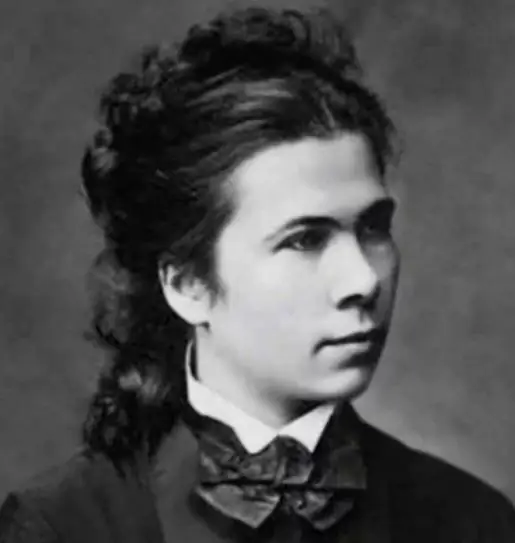- Author Antonio Harrison [email protected].
- Public 2023-12-16 07:44.
- Last modified 2025-01-22 21:44.
Nadezhda Prokofievna Suslova went down in history as the first woman doctor in the Russian Empire. She practiced medicine since the late 1860s, first in St. Petersburg, and then in Nizhny Novgorod and Crimea. It is interesting that the no less famous Apollinaria Suslova, the beloved of the writer Fyodor Mikhailovich Dostoevsky, was the sister of Nadezhda Prokofievna.

early years
Nadezhda Suslova was born in the Nizhny Novgorod province in the village of Panino on September 13, 1843 in a new style. She was one of the two daughters of a serf peasant who, having received freedom from his master (he was Count Sheremetev), managed to become a successful merchant and owner of a cotton paper factory. Nadezhda, like her sister Apollinaria, her father wanted to give a decent education. Therefore, at first the girls studied at home with their mother, and then in the Moscow boarding house Penichkau.
In 1859, Nadezhda Suslova moved to St. Petersburg. Here one of her hobbies was literature. She even tried to write stories herself. In 1861, two of her works were published in Nekrasov's journal Sovremennik - Fantasy and Story in Letters.
At some point, Nadezhda got acquainted with the work of Nikolai Chernyshevsky and became her own among the revolutionary democrats. In the 1860s, she was a member of the populist organization "Land and Freedom", for which she came under police surveillance for some time. But politics still did not become her life's work …
Study in St. Petersburg and Switzerland
At some point, Nadezhda firmly decided to study as a doctor, and this was a rather ambitious decision: in those years in tsarist Russia, women did not have the right to receive higher education. However, several teachers of the St. Petersburg Medical-Surgical Academy in 1862 still allowed three girls, including Suslova, to attend their lectures.
Nadezhda was a very diligent and talented student. In the same 1862, she wrote and published in the "Medical Bulletin" her first scientific article entitled "Change in skin sensations under the influence of electrical stimulation."
Alas, Nadezhda was not allowed to finish her studies quietly in St. Petersburg. In 1863, the then government explicitly banned the fairer sex from attending university lectures. But Nadezhda Prokofievna did not give up and went to get further education in Switzerland. In 1864, she became a student at the University of Zurich, and in 1867 she became a doctor "in medicine, surgery and obstetrics." Her dissertation was titled "Report on the Physiology of Lymph", it was written under the guidance of the famous Russian scientist Ivan Mikhailovich Sechenov.
The defense of this dissertation took place with a large audience, because it was the first such event in the history of a Swiss university. But this did not prevent Suslova from confidently presenting her work and receiving the coveted doctoral degree.
Return to Russia and further biography
In the spring of 1868, Nadezhda Prokofievna first married a Swiss physician, Friedrich Guldreich Erisman. But in the end, the girl did not want to build a career abroad; soon after the wedding, she and her husband arrived in St. Petersburg. Here she had to go through repeated exams and defense of a thesis. Only after that was she allowed to officially become a practicing doctor in the Russian Empire.
In 1870, Nadezhda Prokofieva moved to her native Nizhny Novgorod. Here she had a great gynecological practice and, starting from 1874, lived in the house number 57 on Bolshaya Soldatskaya Street (now it is Volodarsky Street). In 1878, the marriage union with Erisman actually broke up, but the spouses formalized the divorce only in 1883.
The second husband of Nadezhda was the histologist Alexander Efimovich Golubev. With him, she settled in the Crimea in 1892, where Alexander had his own estate not far from Alushta. Here Nadezhda Prokofievna lived until her death.
In Crimea, the legendary woman doctor launched an extensive charitable work (money for this was earned by the production of wine: the Golubev estate had its own vineyards). She treated local residents for free. And even the medicines for them she paid for herself, having agreed on this with the owner of the local pharmacy.
It is also known that Nadezhda Prokofievna donated money for the construction of the Alushta gymnasium, for the establishment of a rural school. In addition, she paid pensions from her own funds to some veterans of the Russo-Japanese War. And in the city of Nalchik, thanks to her efforts, a small free sanatorium for the poor was opened.
Nadezhda Prokofievna died on April 20, 1918.






